Comprehensive Report on Human Resource Development Strategies
VerifiedAdded on 2024/04/26
|21
|5232
|451
Report
AI Summary
This report provides a comprehensive overview of Human Resource Development (HRD) within a business context. It begins by comparing different learning styles, including Myers-Briggs, Kolb's Learning Style, and Honey and Mumford, emphasizing the importance of understanding individual learning preferences for effective training. The report then delves into the learning curve and the significance of learning transfer in the workplace, particularly within Marks and Spencer (M&S), highlighting the need for tailored training programs. It assesses training needs at various organizational levels within M&S, comparing training methods and their advantages and disadvantages. Furthermore, the report examines the UK government's initiatives for skills development, including apprenticeships, traineeships, and sector skills councils, evaluating their impact on workforce development and addressing challenges in skills gaps. Finally, a training and development event is designed, incorporating ADDIE model principles and focusing on improving communication skills, with a detailed plan for implementation and evaluation. The report concludes by summarizing the key aspects of HRD and its importance in organizational success.

Human Resource Development in action
pg. 1
pg. 1
Paraphrase This Document
Need a fresh take? Get an instant paraphrase of this document with our AI Paraphraser
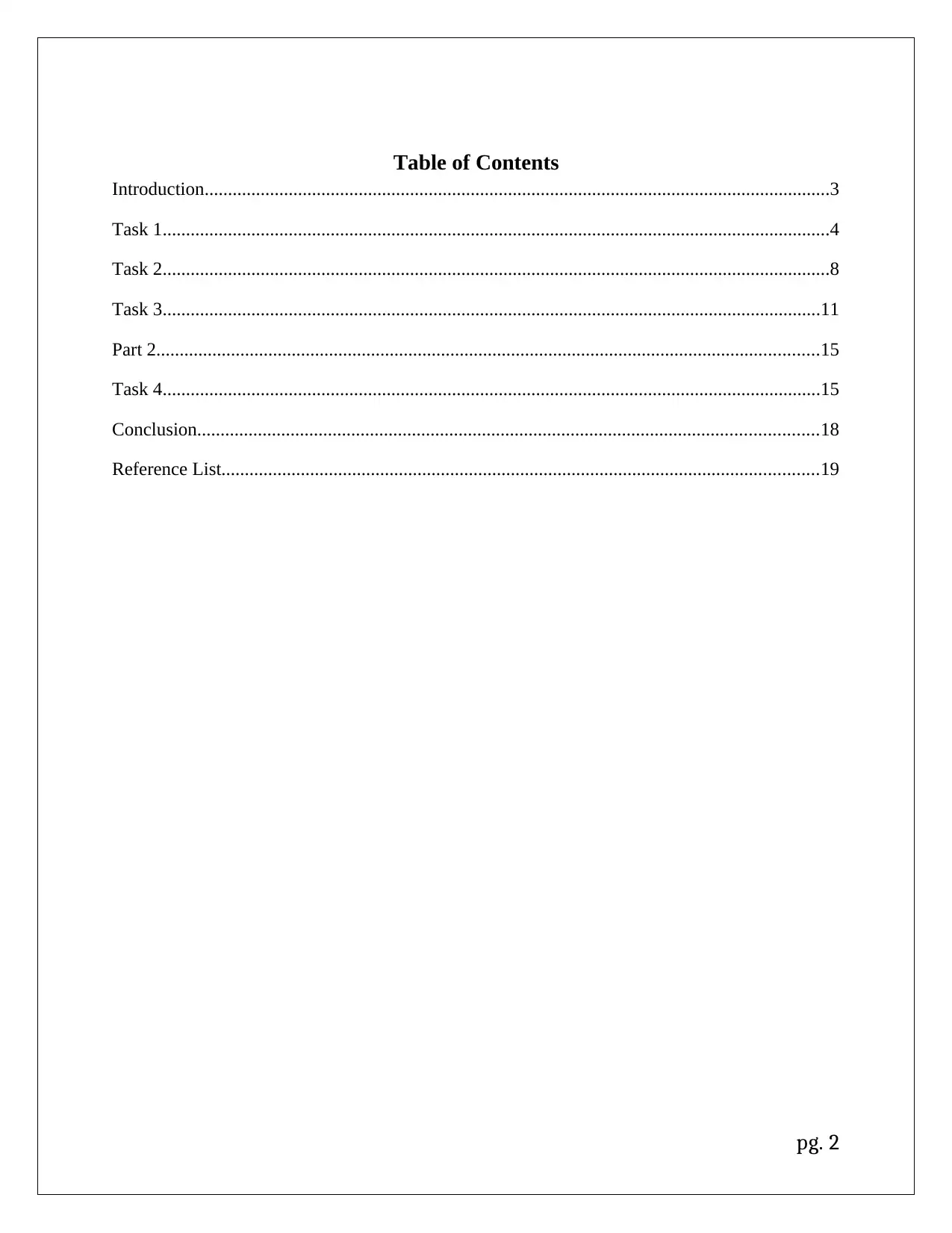
Table of Contents
Introduction......................................................................................................................................3
Task 1...............................................................................................................................................4
Task 2...............................................................................................................................................8
Task 3.............................................................................................................................................11
Part 2..............................................................................................................................................15
Task 4.............................................................................................................................................15
Conclusion.....................................................................................................................................18
Reference List................................................................................................................................19
pg. 2
Introduction......................................................................................................................................3
Task 1...............................................................................................................................................4
Task 2...............................................................................................................................................8
Task 3.............................................................................................................................................11
Part 2..............................................................................................................................................15
Task 4.............................................................................................................................................15
Conclusion.....................................................................................................................................18
Reference List................................................................................................................................19
pg. 2
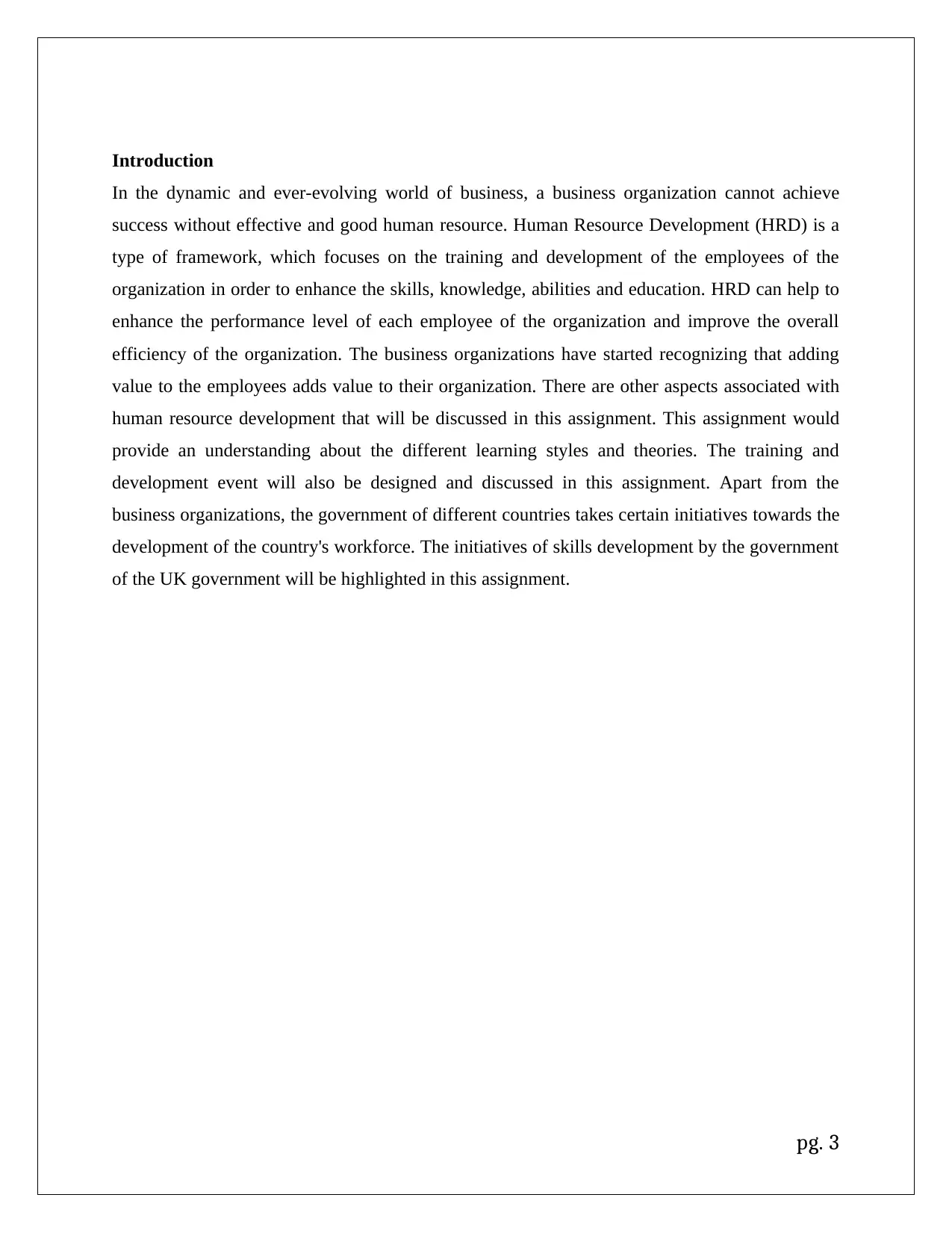
Introduction
In the dynamic and ever-evolving world of business, a business organization cannot achieve
success without effective and good human resource. Human Resource Development (HRD) is a
type of framework, which focuses on the training and development of the employees of the
organization in order to enhance the skills, knowledge, abilities and education. HRD can help to
enhance the performance level of each employee of the organization and improve the overall
efficiency of the organization. The business organizations have started recognizing that adding
value to the employees adds value to their organization. There are other aspects associated with
human resource development that will be discussed in this assignment. This assignment would
provide an understanding about the different learning styles and theories. The training and
development event will also be designed and discussed in this assignment. Apart from the
business organizations, the government of different countries takes certain initiatives towards the
development of the country's workforce. The initiatives of skills development by the government
of the UK government will be highlighted in this assignment.
pg. 3
In the dynamic and ever-evolving world of business, a business organization cannot achieve
success without effective and good human resource. Human Resource Development (HRD) is a
type of framework, which focuses on the training and development of the employees of the
organization in order to enhance the skills, knowledge, abilities and education. HRD can help to
enhance the performance level of each employee of the organization and improve the overall
efficiency of the organization. The business organizations have started recognizing that adding
value to the employees adds value to their organization. There are other aspects associated with
human resource development that will be discussed in this assignment. This assignment would
provide an understanding about the different learning styles and theories. The training and
development event will also be designed and discussed in this assignment. Apart from the
business organizations, the government of different countries takes certain initiatives towards the
development of the country's workforce. The initiatives of skills development by the government
of the UK government will be highlighted in this assignment.
pg. 3
⊘ This is a preview!⊘
Do you want full access?
Subscribe today to unlock all pages.

Trusted by 1+ million students worldwide
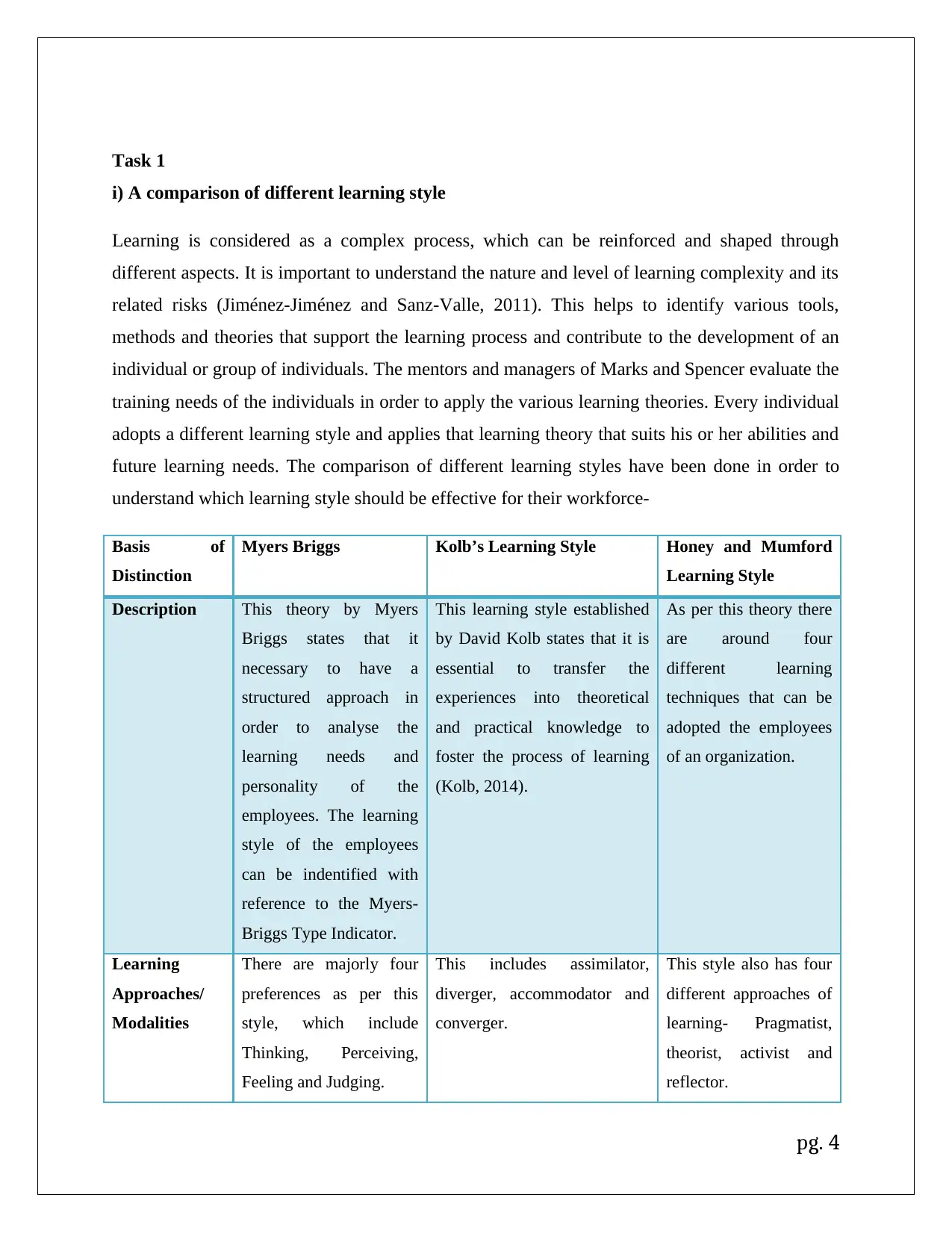
Task 1
i) A comparison of different learning style
Learning is considered as a complex process, which can be reinforced and shaped through
different aspects. It is important to understand the nature and level of learning complexity and its
related risks (Jiménez-Jiménez and Sanz-Valle, 2011). This helps to identify various tools,
methods and theories that support the learning process and contribute to the development of an
individual or group of individuals. The mentors and managers of Marks and Spencer evaluate the
training needs of the individuals in order to apply the various learning theories. Every individual
adopts a different learning style and applies that learning theory that suits his or her abilities and
future learning needs. The comparison of different learning styles have been done in order to
understand which learning style should be effective for their workforce-
Basis of
Distinction
Myers Briggs Kolb’s Learning Style Honey and Mumford
Learning Style
Description This theory by Myers
Briggs states that it
necessary to have a
structured approach in
order to analyse the
learning needs and
personality of the
employees. The learning
style of the employees
can be indentified with
reference to the Myers-
Briggs Type Indicator.
This learning style established
by David Kolb states that it is
essential to transfer the
experiences into theoretical
and practical knowledge to
foster the process of learning
(Kolb, 2014).
As per this theory there
are around four
different learning
techniques that can be
adopted the employees
of an organization.
Learning
Approaches/
Modalities
There are majorly four
preferences as per this
style, which include
Thinking, Perceiving,
Feeling and Judging.
This includes assimilator,
diverger, accommodator and
converger.
This style also has four
different approaches of
learning- Pragmatist,
theorist, activist and
reflector.
pg. 4
i) A comparison of different learning style
Learning is considered as a complex process, which can be reinforced and shaped through
different aspects. It is important to understand the nature and level of learning complexity and its
related risks (Jiménez-Jiménez and Sanz-Valle, 2011). This helps to identify various tools,
methods and theories that support the learning process and contribute to the development of an
individual or group of individuals. The mentors and managers of Marks and Spencer evaluate the
training needs of the individuals in order to apply the various learning theories. Every individual
adopts a different learning style and applies that learning theory that suits his or her abilities and
future learning needs. The comparison of different learning styles have been done in order to
understand which learning style should be effective for their workforce-
Basis of
Distinction
Myers Briggs Kolb’s Learning Style Honey and Mumford
Learning Style
Description This theory by Myers
Briggs states that it
necessary to have a
structured approach in
order to analyse the
learning needs and
personality of the
employees. The learning
style of the employees
can be indentified with
reference to the Myers-
Briggs Type Indicator.
This learning style established
by David Kolb states that it is
essential to transfer the
experiences into theoretical
and practical knowledge to
foster the process of learning
(Kolb, 2014).
As per this theory there
are around four
different learning
techniques that can be
adopted the employees
of an organization.
Learning
Approaches/
Modalities
There are majorly four
preferences as per this
style, which include
Thinking, Perceiving,
Feeling and Judging.
This includes assimilator,
diverger, accommodator and
converger.
This style also has four
different approaches of
learning- Pragmatist,
theorist, activist and
reflector.
pg. 4
Paraphrase This Document
Need a fresh take? Get an instant paraphrase of this document with our AI Paraphraser
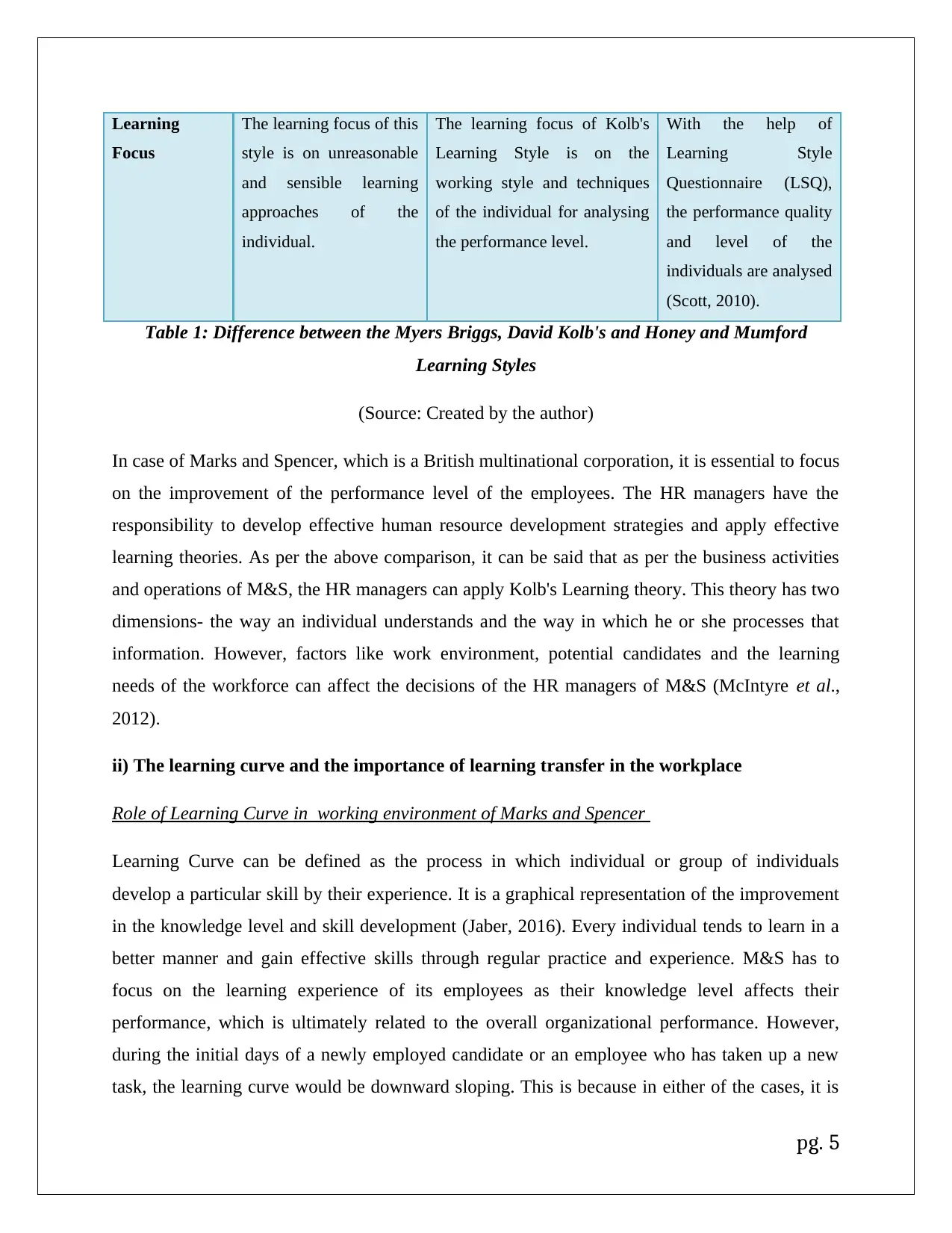
Learning
Focus
The learning focus of this
style is on unreasonable
and sensible learning
approaches of the
individual.
The learning focus of Kolb's
Learning Style is on the
working style and techniques
of the individual for analysing
the performance level.
With the help of
Learning Style
Questionnaire (LSQ),
the performance quality
and level of the
individuals are analysed
(Scott, 2010).
Table 1: Difference between the Myers Briggs, David Kolb's and Honey and Mumford
Learning Styles
(Source: Created by the author)
In case of Marks and Spencer, which is a British multinational corporation, it is essential to focus
on the improvement of the performance level of the employees. The HR managers have the
responsibility to develop effective human resource development strategies and apply effective
learning theories. As per the above comparison, it can be said that as per the business activities
and operations of M&S, the HR managers can apply Kolb's Learning theory. This theory has two
dimensions- the way an individual understands and the way in which he or she processes that
information. However, factors like work environment, potential candidates and the learning
needs of the workforce can affect the decisions of the HR managers of M&S (McIntyre et al.,
2012).
ii) The learning curve and the importance of learning transfer in the workplace
Role of Learning Curve in working environment of Marks and Spencer
Learning Curve can be defined as the process in which individual or group of individuals
develop a particular skill by their experience. It is a graphical representation of the improvement
in the knowledge level and skill development (Jaber, 2016). Every individual tends to learn in a
better manner and gain effective skills through regular practice and experience. M&S has to
focus on the learning experience of its employees as their knowledge level affects their
performance, which is ultimately related to the overall organizational performance. However,
during the initial days of a newly employed candidate or an employee who has taken up a new
task, the learning curve would be downward sloping. This is because in either of the cases, it is
pg. 5
Focus
The learning focus of this
style is on unreasonable
and sensible learning
approaches of the
individual.
The learning focus of Kolb's
Learning Style is on the
working style and techniques
of the individual for analysing
the performance level.
With the help of
Learning Style
Questionnaire (LSQ),
the performance quality
and level of the
individuals are analysed
(Scott, 2010).
Table 1: Difference between the Myers Briggs, David Kolb's and Honey and Mumford
Learning Styles
(Source: Created by the author)
In case of Marks and Spencer, which is a British multinational corporation, it is essential to focus
on the improvement of the performance level of the employees. The HR managers have the
responsibility to develop effective human resource development strategies and apply effective
learning theories. As per the above comparison, it can be said that as per the business activities
and operations of M&S, the HR managers can apply Kolb's Learning theory. This theory has two
dimensions- the way an individual understands and the way in which he or she processes that
information. However, factors like work environment, potential candidates and the learning
needs of the workforce can affect the decisions of the HR managers of M&S (McIntyre et al.,
2012).
ii) The learning curve and the importance of learning transfer in the workplace
Role of Learning Curve in working environment of Marks and Spencer
Learning Curve can be defined as the process in which individual or group of individuals
develop a particular skill by their experience. It is a graphical representation of the improvement
in the knowledge level and skill development (Jaber, 2016). Every individual tends to learn in a
better manner and gain effective skills through regular practice and experience. M&S has to
focus on the learning experience of its employees as their knowledge level affects their
performance, which is ultimately related to the overall organizational performance. However,
during the initial days of a newly employed candidate or an employee who has taken up a new
task, the learning curve would be downward sloping. This is because in either of the cases, it is
pg. 5

believed that the individual would take more time to comprehend and perform as per the
requirement. After regular attempts and practices, the individual would gain knowledge and
acquire the right skills to perform the task. Hence, it is essential for the business organizations to
evaluate and monitor the performance level of the employees (Jones and Jones, 2010). M&S
focuses on tailoring improving the skills and knowledge of its employees by tailoring the training
and development sessions after effectively evaluating the learning needs of their employees.
Significance of Learning Transfer in the workplace of Marks and Spencer
Transfer of learning is related to the extent to which a person applies his or her own skills,
behaviour and learned knowledge to an entire new situation. The competition between
companies in different sectors has been increasing because of which the business organizations
have started focussing on the performance level of their workforce (Cormier and Hagman, 2014).
The professional of training and development increasingly go on valuing the importance of
expanding the knowledge and skills set of the workforce. The functions of HR managers have
various aspects out of which recruitment and selection is the most important. Hiring the right
candidate for the right position and at the right time is essential for the HR managers. The HR
department of M&S focus on developing effective induction programme so that they can provide
the basic knowledge to the new candidates (Armstrong and Taylor, 2014). The training and
development program of M&S are also developed after considering the high performance system
and working standards of the organization. Continuous monitoring and evaluation of the
performance level of the employees facilitates the HR managers to understand the learning
needs. These valuable measures taken by the company helps the employees to retain their
learned knowledge and apply it correctly during practical execution.
iii) Importance of learning styles and theories when planning and designing learning
event
The needs of the complex business environment tend to grow every day. Along with this, the
organizational structure and market position of the business organization also brings new type of
challenges to the business organization. The management of M&S have to focus on how
effectively they can manage the performance of the workforce in order to ensure the organization
is able to maintain the market position. M&S focuses on training and development of its
pg. 6
requirement. After regular attempts and practices, the individual would gain knowledge and
acquire the right skills to perform the task. Hence, it is essential for the business organizations to
evaluate and monitor the performance level of the employees (Jones and Jones, 2010). M&S
focuses on tailoring improving the skills and knowledge of its employees by tailoring the training
and development sessions after effectively evaluating the learning needs of their employees.
Significance of Learning Transfer in the workplace of Marks and Spencer
Transfer of learning is related to the extent to which a person applies his or her own skills,
behaviour and learned knowledge to an entire new situation. The competition between
companies in different sectors has been increasing because of which the business organizations
have started focussing on the performance level of their workforce (Cormier and Hagman, 2014).
The professional of training and development increasingly go on valuing the importance of
expanding the knowledge and skills set of the workforce. The functions of HR managers have
various aspects out of which recruitment and selection is the most important. Hiring the right
candidate for the right position and at the right time is essential for the HR managers. The HR
department of M&S focus on developing effective induction programme so that they can provide
the basic knowledge to the new candidates (Armstrong and Taylor, 2014). The training and
development program of M&S are also developed after considering the high performance system
and working standards of the organization. Continuous monitoring and evaluation of the
performance level of the employees facilitates the HR managers to understand the learning
needs. These valuable measures taken by the company helps the employees to retain their
learned knowledge and apply it correctly during practical execution.
iii) Importance of learning styles and theories when planning and designing learning
event
The needs of the complex business environment tend to grow every day. Along with this, the
organizational structure and market position of the business organization also brings new type of
challenges to the business organization. The management of M&S have to focus on how
effectively they can manage the performance of the workforce in order to ensure the organization
is able to maintain the market position. M&S focuses on training and development of its
pg. 6
⊘ This is a preview!⊘
Do you want full access?
Subscribe today to unlock all pages.

Trusted by 1+ million students worldwide
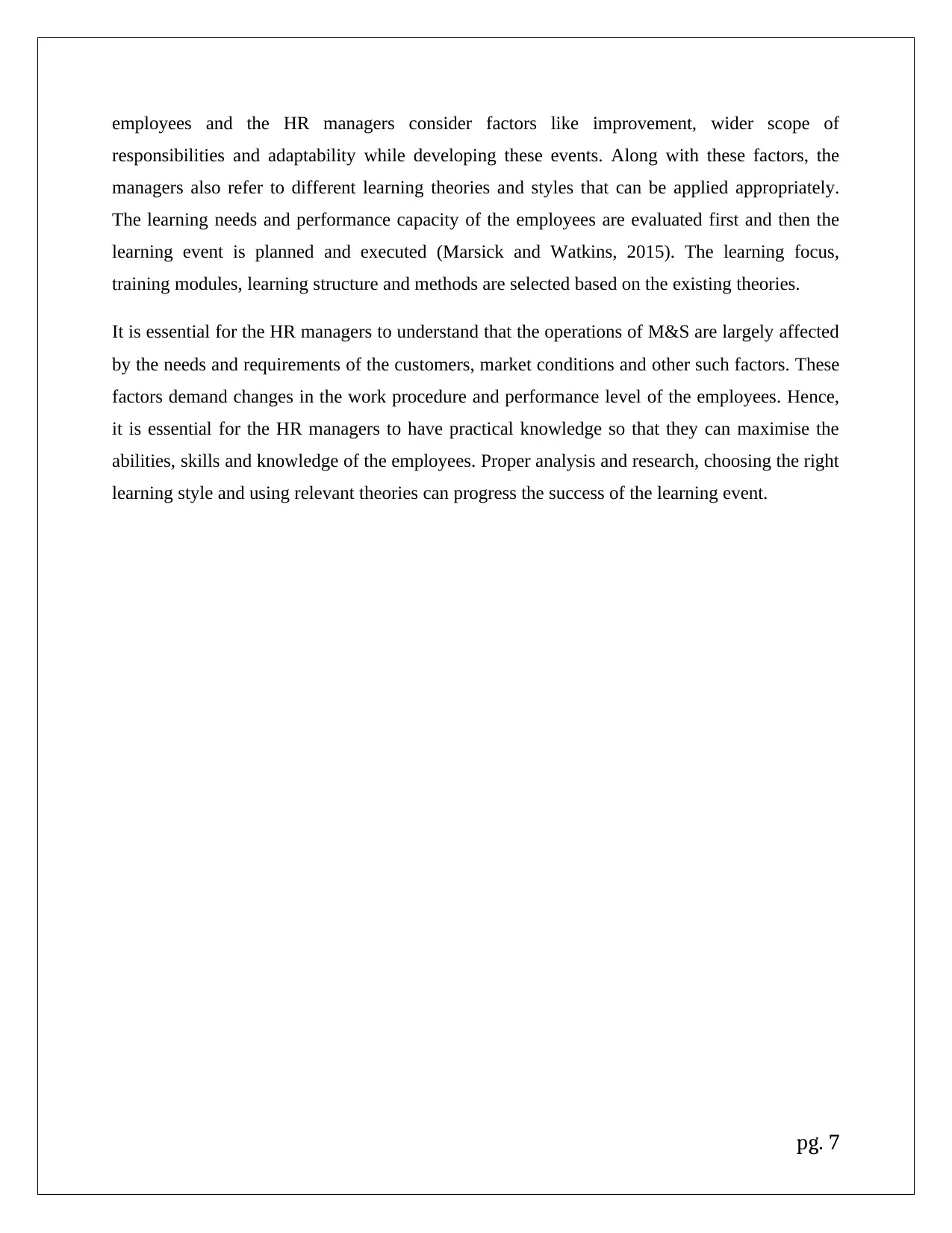
employees and the HR managers consider factors like improvement, wider scope of
responsibilities and adaptability while developing these events. Along with these factors, the
managers also refer to different learning theories and styles that can be applied appropriately.
The learning needs and performance capacity of the employees are evaluated first and then the
learning event is planned and executed (Marsick and Watkins, 2015). The learning focus,
training modules, learning structure and methods are selected based on the existing theories.
It is essential for the HR managers to understand that the operations of M&S are largely affected
by the needs and requirements of the customers, market conditions and other such factors. These
factors demand changes in the work procedure and performance level of the employees. Hence,
it is essential for the HR managers to have practical knowledge so that they can maximise the
abilities, skills and knowledge of the employees. Proper analysis and research, choosing the right
learning style and using relevant theories can progress the success of the learning event.
pg. 7
responsibilities and adaptability while developing these events. Along with these factors, the
managers also refer to different learning theories and styles that can be applied appropriately.
The learning needs and performance capacity of the employees are evaluated first and then the
learning event is planned and executed (Marsick and Watkins, 2015). The learning focus,
training modules, learning structure and methods are selected based on the existing theories.
It is essential for the HR managers to understand that the operations of M&S are largely affected
by the needs and requirements of the customers, market conditions and other such factors. These
factors demand changes in the work procedure and performance level of the employees. Hence,
it is essential for the HR managers to have practical knowledge so that they can maximise the
abilities, skills and knowledge of the employees. Proper analysis and research, choosing the right
learning style and using relevant theories can progress the success of the learning event.
pg. 7
Paraphrase This Document
Need a fresh take? Get an instant paraphrase of this document with our AI Paraphraser
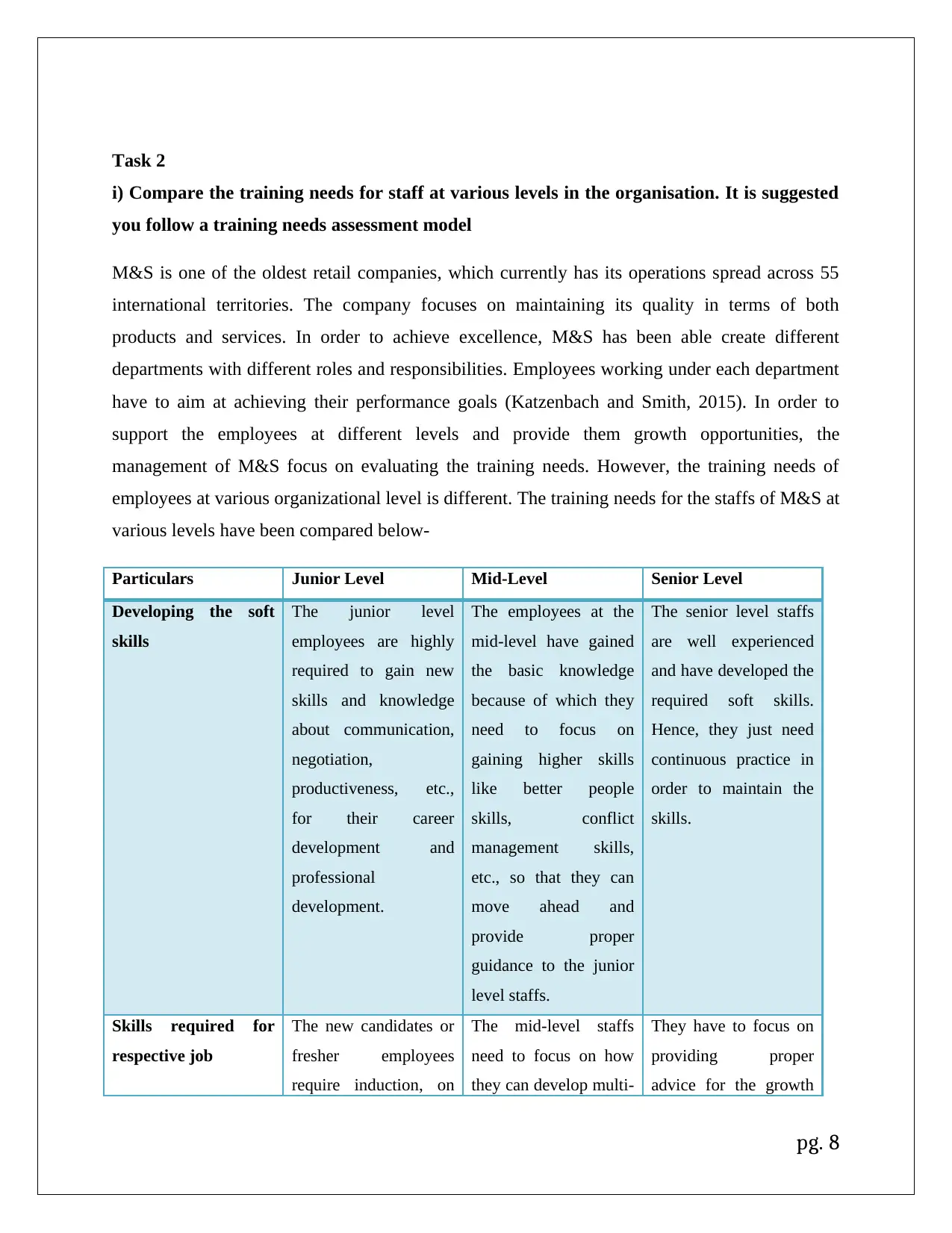
Task 2
i) Compare the training needs for staff at various levels in the organisation. It is suggested
you follow a training needs assessment model
M&S is one of the oldest retail companies, which currently has its operations spread across 55
international territories. The company focuses on maintaining its quality in terms of both
products and services. In order to achieve excellence, M&S has been able create different
departments with different roles and responsibilities. Employees working under each department
have to aim at achieving their performance goals (Katzenbach and Smith, 2015). In order to
support the employees at different levels and provide them growth opportunities, the
management of M&S focus on evaluating the training needs. However, the training needs of
employees at various organizational level is different. The training needs for the staffs of M&S at
various levels have been compared below-
Particulars Junior Level Mid-Level Senior Level
Developing the soft
skills
The junior level
employees are highly
required to gain new
skills and knowledge
about communication,
negotiation,
productiveness, etc.,
for their career
development and
professional
development.
The employees at the
mid-level have gained
the basic knowledge
because of which they
need to focus on
gaining higher skills
like better people
skills, conflict
management skills,
etc., so that they can
move ahead and
provide proper
guidance to the junior
level staffs.
The senior level staffs
are well experienced
and have developed the
required soft skills.
Hence, they just need
continuous practice in
order to maintain the
skills.
Skills required for
respective job
The new candidates or
fresher employees
require induction, on
The mid-level staffs
need to focus on how
they can develop multi-
They have to focus on
providing proper
advice for the growth
pg. 8
i) Compare the training needs for staff at various levels in the organisation. It is suggested
you follow a training needs assessment model
M&S is one of the oldest retail companies, which currently has its operations spread across 55
international territories. The company focuses on maintaining its quality in terms of both
products and services. In order to achieve excellence, M&S has been able create different
departments with different roles and responsibilities. Employees working under each department
have to aim at achieving their performance goals (Katzenbach and Smith, 2015). In order to
support the employees at different levels and provide them growth opportunities, the
management of M&S focus on evaluating the training needs. However, the training needs of
employees at various organizational level is different. The training needs for the staffs of M&S at
various levels have been compared below-
Particulars Junior Level Mid-Level Senior Level
Developing the soft
skills
The junior level
employees are highly
required to gain new
skills and knowledge
about communication,
negotiation,
productiveness, etc.,
for their career
development and
professional
development.
The employees at the
mid-level have gained
the basic knowledge
because of which they
need to focus on
gaining higher skills
like better people
skills, conflict
management skills,
etc., so that they can
move ahead and
provide proper
guidance to the junior
level staffs.
The senior level staffs
are well experienced
and have developed the
required soft skills.
Hence, they just need
continuous practice in
order to maintain the
skills.
Skills required for
respective job
The new candidates or
fresher employees
require induction, on
The mid-level staffs
need to focus on how
they can develop multi-
They have to focus on
providing proper
advice for the growth
pg. 8
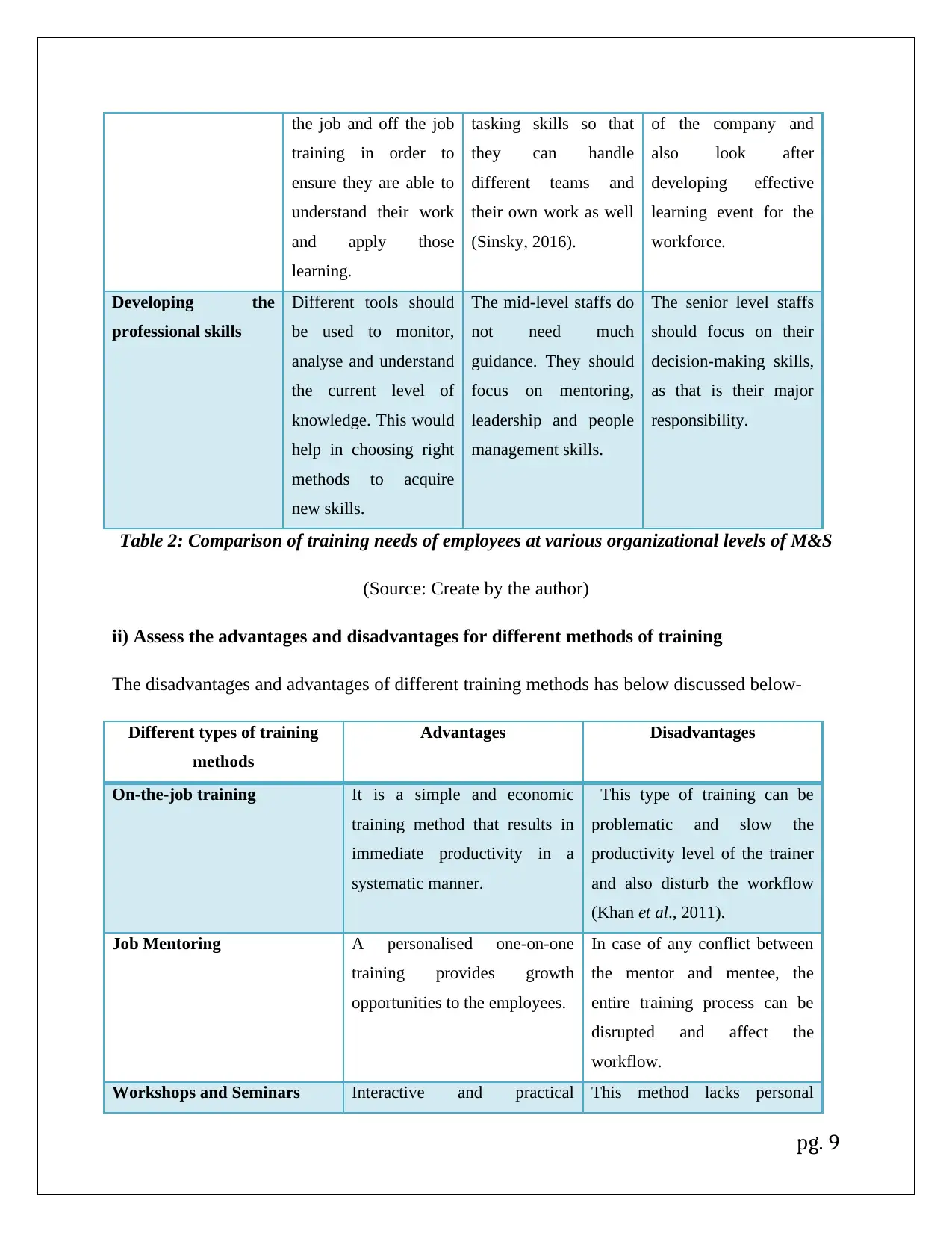
the job and off the job
training in order to
ensure they are able to
understand their work
and apply those
learning.
tasking skills so that
they can handle
different teams and
their own work as well
(Sinsky, 2016).
of the company and
also look after
developing effective
learning event for the
workforce.
Developing the
professional skills
Different tools should
be used to monitor,
analyse and understand
the current level of
knowledge. This would
help in choosing right
methods to acquire
new skills.
The mid-level staffs do
not need much
guidance. They should
focus on mentoring,
leadership and people
management skills.
The senior level staffs
should focus on their
decision-making skills,
as that is their major
responsibility.
Table 2: Comparison of training needs of employees at various organizational levels of M&S
(Source: Create by the author)
ii) Assess the advantages and disadvantages for different methods of training
The disadvantages and advantages of different training methods has below discussed below-
Different types of training
methods
Advantages Disadvantages
On-the-job training It is a simple and economic
training method that results in
immediate productivity in a
systematic manner.
This type of training can be
problematic and slow the
productivity level of the trainer
and also disturb the workflow
(Khan et al., 2011).
Job Mentoring A personalised one-on-one
training provides growth
opportunities to the employees.
In case of any conflict between
the mentor and mentee, the
entire training process can be
disrupted and affect the
workflow.
Workshops and Seminars Interactive and practical This method lacks personal
pg. 9
training in order to
ensure they are able to
understand their work
and apply those
learning.
tasking skills so that
they can handle
different teams and
their own work as well
(Sinsky, 2016).
of the company and
also look after
developing effective
learning event for the
workforce.
Developing the
professional skills
Different tools should
be used to monitor,
analyse and understand
the current level of
knowledge. This would
help in choosing right
methods to acquire
new skills.
The mid-level staffs do
not need much
guidance. They should
focus on mentoring,
leadership and people
management skills.
The senior level staffs
should focus on their
decision-making skills,
as that is their major
responsibility.
Table 2: Comparison of training needs of employees at various organizational levels of M&S
(Source: Create by the author)
ii) Assess the advantages and disadvantages for different methods of training
The disadvantages and advantages of different training methods has below discussed below-
Different types of training
methods
Advantages Disadvantages
On-the-job training It is a simple and economic
training method that results in
immediate productivity in a
systematic manner.
This type of training can be
problematic and slow the
productivity level of the trainer
and also disturb the workflow
(Khan et al., 2011).
Job Mentoring A personalised one-on-one
training provides growth
opportunities to the employees.
In case of any conflict between
the mentor and mentee, the
entire training process can be
disrupted and affect the
workflow.
Workshops and Seminars Interactive and practical This method lacks personal
pg. 9
⊘ This is a preview!⊘
Do you want full access?
Subscribe today to unlock all pages.

Trusted by 1+ million students worldwide
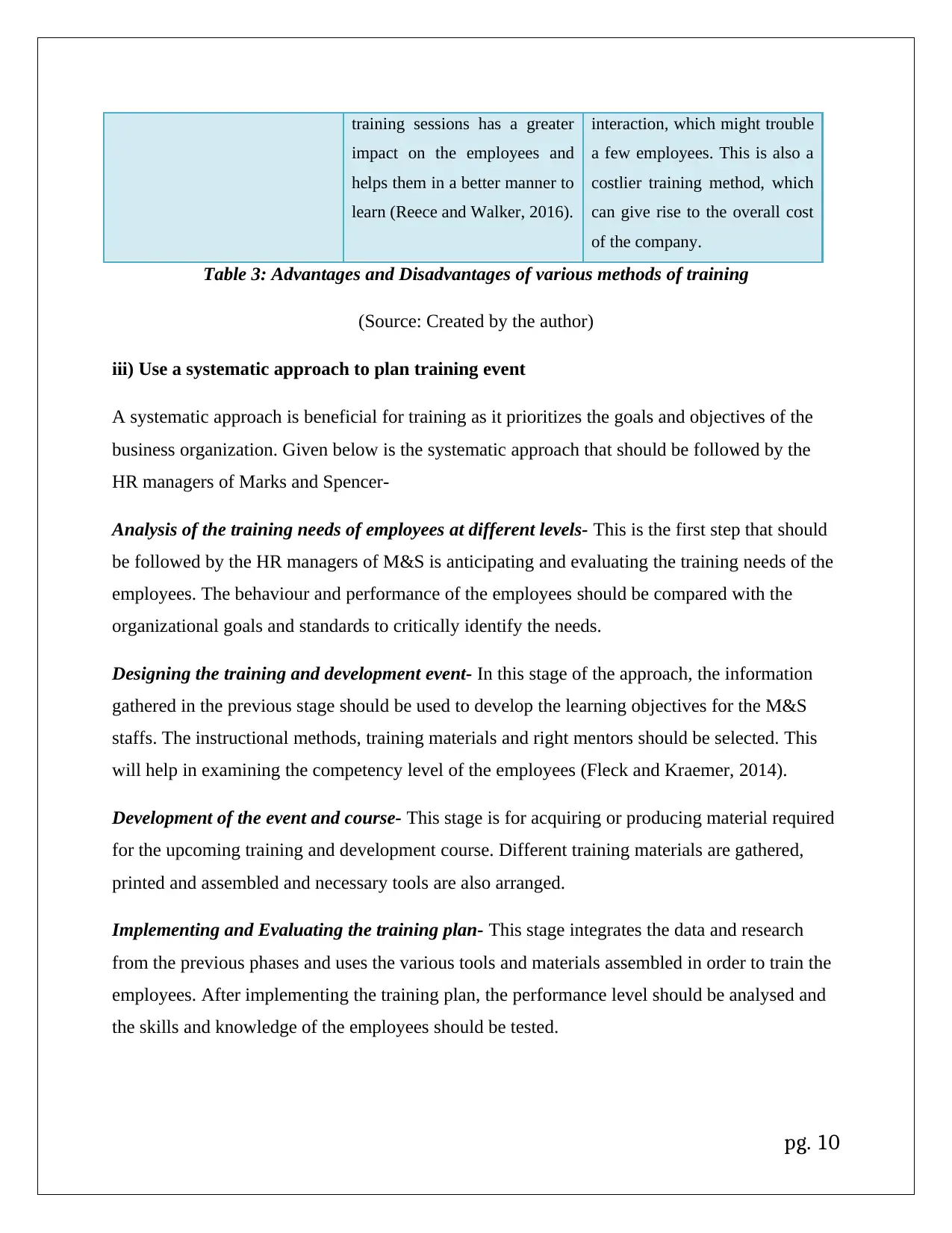
training sessions has a greater
impact on the employees and
helps them in a better manner to
learn (Reece and Walker, 2016).
interaction, which might trouble
a few employees. This is also a
costlier training method, which
can give rise to the overall cost
of the company.
Table 3: Advantages and Disadvantages of various methods of training
(Source: Created by the author)
iii) Use a systematic approach to plan training event
A systematic approach is beneficial for training as it prioritizes the goals and objectives of the
business organization. Given below is the systematic approach that should be followed by the
HR managers of Marks and Spencer-
Analysis of the training needs of employees at different levels- This is the first step that should
be followed by the HR managers of M&S is anticipating and evaluating the training needs of the
employees. The behaviour and performance of the employees should be compared with the
organizational goals and standards to critically identify the needs.
Designing the training and development event- In this stage of the approach, the information
gathered in the previous stage should be used to develop the learning objectives for the M&S
staffs. The instructional methods, training materials and right mentors should be selected. This
will help in examining the competency level of the employees (Fleck and Kraemer, 2014).
Development of the event and course- This stage is for acquiring or producing material required
for the upcoming training and development course. Different training materials are gathered,
printed and assembled and necessary tools are also arranged.
Implementing and Evaluating the training plan- This stage integrates the data and research
from the previous phases and uses the various tools and materials assembled in order to train the
employees. After implementing the training plan, the performance level should be analysed and
the skills and knowledge of the employees should be tested.
pg. 10
impact on the employees and
helps them in a better manner to
learn (Reece and Walker, 2016).
interaction, which might trouble
a few employees. This is also a
costlier training method, which
can give rise to the overall cost
of the company.
Table 3: Advantages and Disadvantages of various methods of training
(Source: Created by the author)
iii) Use a systematic approach to plan training event
A systematic approach is beneficial for training as it prioritizes the goals and objectives of the
business organization. Given below is the systematic approach that should be followed by the
HR managers of Marks and Spencer-
Analysis of the training needs of employees at different levels- This is the first step that should
be followed by the HR managers of M&S is anticipating and evaluating the training needs of the
employees. The behaviour and performance of the employees should be compared with the
organizational goals and standards to critically identify the needs.
Designing the training and development event- In this stage of the approach, the information
gathered in the previous stage should be used to develop the learning objectives for the M&S
staffs. The instructional methods, training materials and right mentors should be selected. This
will help in examining the competency level of the employees (Fleck and Kraemer, 2014).
Development of the event and course- This stage is for acquiring or producing material required
for the upcoming training and development course. Different training materials are gathered,
printed and assembled and necessary tools are also arranged.
Implementing and Evaluating the training plan- This stage integrates the data and research
from the previous phases and uses the various tools and materials assembled in order to train the
employees. After implementing the training plan, the performance level should be analysed and
the skills and knowledge of the employees should be tested.
pg. 10
Paraphrase This Document
Need a fresh take? Get an instant paraphrase of this document with our AI Paraphraser
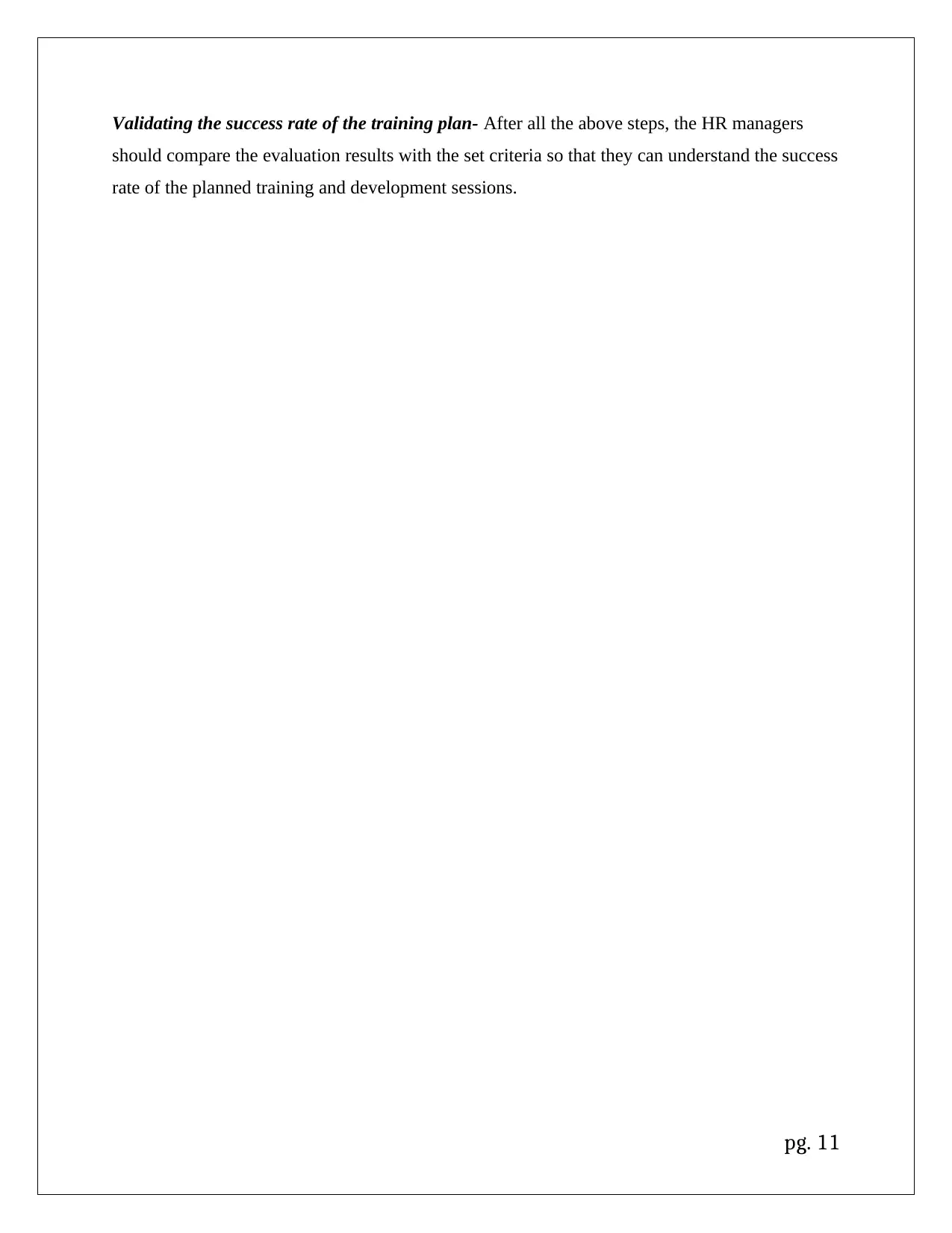
Validating the success rate of the training plan- After all the above steps, the HR managers
should compare the evaluation results with the set criteria so that they can understand the success
rate of the planned training and development sessions.
pg. 11
should compare the evaluation results with the set criteria so that they can understand the success
rate of the planned training and development sessions.
pg. 11
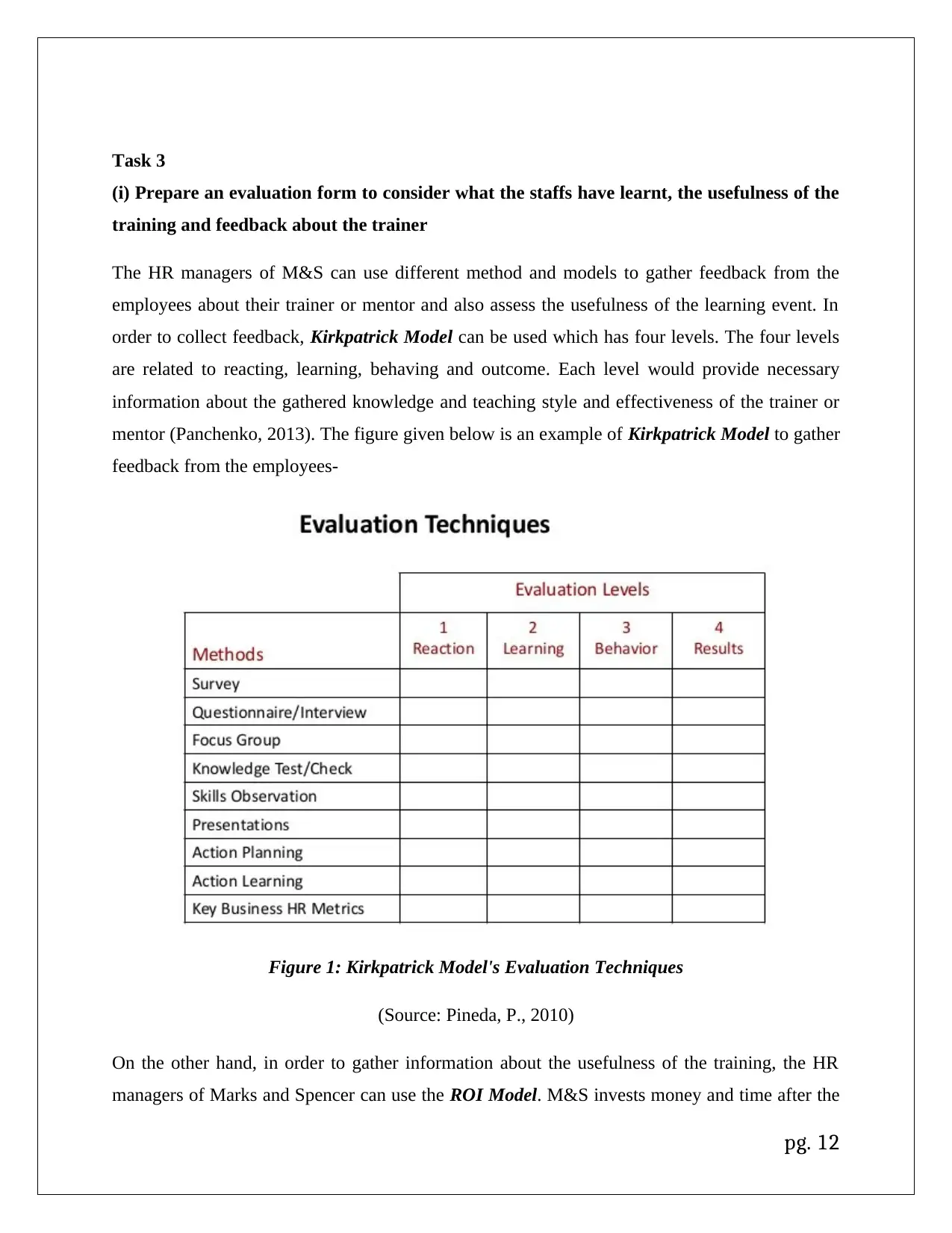
Task 3
(i) Prepare an evaluation form to consider what the staffs have learnt, the usefulness of the
training and feedback about the trainer
The HR managers of M&S can use different method and models to gather feedback from the
employees about their trainer or mentor and also assess the usefulness of the learning event. In
order to collect feedback, Kirkpatrick Model can be used which has four levels. The four levels
are related to reacting, learning, behaving and outcome. Each level would provide necessary
information about the gathered knowledge and teaching style and effectiveness of the trainer or
mentor (Panchenko, 2013). The figure given below is an example of Kirkpatrick Model to gather
feedback from the employees-
Figure 1: Kirkpatrick Model's Evaluation Techniques
(Source: Pineda, P., 2010)
On the other hand, in order to gather information about the usefulness of the training, the HR
managers of Marks and Spencer can use the ROI Model. M&S invests money and time after the
pg. 12
(i) Prepare an evaluation form to consider what the staffs have learnt, the usefulness of the
training and feedback about the trainer
The HR managers of M&S can use different method and models to gather feedback from the
employees about their trainer or mentor and also assess the usefulness of the learning event. In
order to collect feedback, Kirkpatrick Model can be used which has four levels. The four levels
are related to reacting, learning, behaving and outcome. Each level would provide necessary
information about the gathered knowledge and teaching style and effectiveness of the trainer or
mentor (Panchenko, 2013). The figure given below is an example of Kirkpatrick Model to gather
feedback from the employees-
Figure 1: Kirkpatrick Model's Evaluation Techniques
(Source: Pineda, P., 2010)
On the other hand, in order to gather information about the usefulness of the training, the HR
managers of Marks and Spencer can use the ROI Model. M&S invests money and time after the
pg. 12
⊘ This is a preview!⊘
Do you want full access?
Subscribe today to unlock all pages.

Trusted by 1+ million students worldwide
1 out of 21
Related Documents
Your All-in-One AI-Powered Toolkit for Academic Success.
+13062052269
info@desklib.com
Available 24*7 on WhatsApp / Email
![[object Object]](/_next/static/media/star-bottom.7253800d.svg)
Unlock your academic potential
Copyright © 2020–2025 A2Z Services. All Rights Reserved. Developed and managed by ZUCOL.





